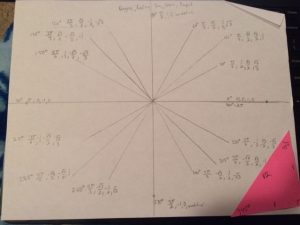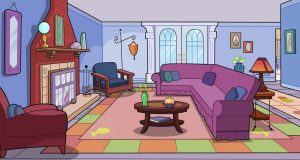High School: Geometry
SIMILARITY WITH TRIANGLES
The class I will be teaching will be a 9th grade high school
Geometry class. The textbook used will be Geometry:
Integration, Application, Connection by Glencoe and McGraw-
Hill Companies published in 2001. This learning progression
will follow the student through meeting the Common Core
State Standards about proving theorems involving similarities
with triangles. These Common Core State Standards will be
covered in chapter 7 of the textbook, sections 3, 4, and 5. The
Standards for this learning progression will be the cluster
involving proving theorems involving similarity, which are
CCSS.Math.Content.HSG.SRT.B.4 and
CCSS.Math.Content.HSG.SRT.B.5. The math practices that are
going to be used throughout the learning progression are as
follows: MP3, MP4 and MP5.
CCSS.Math.Content.HSG.SRT.B.4:
Prove theorems about triangles. Theorems
include: a line parallel to one side of a
triangle divides the other two proportionally,
and conversely.
CCSS.Math.Content.HSG.SRT.B.5:
Use congruence and similarity criteria for
triangles to solve problems and to prove
relationships in geometric figures.
COMMON CORE STATE STANDARDS
MATHEMATICAL PRACTICES
CCSS.Math.Practice.MP3:
Construct viable arguments and critique the
reasoning of others.
CCSS.Math.Practice.MP4:
Model with mathematics.
CCSS.Math.Practice.MP5:
Use appropriate tools strategically.
Lesson 7-3 Identifying Similar Triangles
For this lesson I will start out by putting a picture under the
document camera of the pyramids in Egypt and explain how
Greek mathematician Thales used geometry for the first
time to solve for the height of the Great Pyramids. I will
write the hinge question on the white board on the side for
the students to consider throughout the lesson. The
students should be able to answer the hinge question by the
end of the lesson. The CCSS covered in this lesson is the first
part of the math standard HSG.SRT.B.5 about solving
problems for triangles with similarity and congruence.
I will follow the introduction with notes for the class in
which I will go through some example of the concepts under
the document camera for the student to copy down. I will
go through three similarities and examples for each to show
the students how they can use the similarity to solve
problems. The similarities are angle-angle (AA), side-sideside
(SSS), and side-angle-side (SAS). While going through
examples, I will be very student involved and ask students
questions as often as possible to have them solving the
problems with me. Once we have finished that, I will ask the
student if they have any questions on anything we have
done so far.
Next, we will do a hand on activity. The students will need a
ruler and protractor. Since the students will be using the
tools and drawing the triangles they will be using MP4 and
MP5. The students will draw a triangle and measure all the
sides of the triangle. They will then draw another triangle
with a scale factor of ½ of 2. They measure the angles of the
triangles to compare. They will answer the questions: Are
these triangles similar? Why? Which triangle similarity is
this? Answer: Since the sides are proportionate the triangles
are similar and this is the SSS similarity. The students
checked their answer by measuring the angles which could
be AA similarity. The students will be assigned homework in
which some problems will be basic problems directly using
the formulas while some of the problems will be real world
problems where the students will have to apply the material
and make connections to solve the problem. Therefore,
being able to answer the hinge question.
Hinge Question:
How can you use similar triangles to
solve problems?
Common Core State Standard:
CCSS.Math.Content.HSG.SRT.B.5:
Use congruence and similarity criteria
for triangles to solve problems and to
prove relationships in geometric
figures.
Angle-Angle (AA) Similarity:
If two angles of one triangle are
congruent to two angles of another
triangle, then the triangles are similar.
Side-Side-Side (SSS) Similarity:
If the measures of the corresponding
sides of two triangles are proportional,
then the triangles are similar.
Side-Angle-Side (SAS) Similarity:
If the measures of two sides of a
triangle are proportional to the
measures of two corresponding sides of
another triangle and the included
angles are congruent, then the triangles
are similar.
CCSS.Math.Practice.MP4:
Model with mathematics.
CCSS.Math.Practice.MP5:
Use appropriate tools strategically.
Lesson 7-4 Parallel Lines and Proportional Parts
I will start this activity with a warm-up related to the last
activity. I will give the students two triangles with two sides
labeled and the angle between the sides labeled as well. The
students will have to show these are similar triangles using
SAS similarity. This will be used as a way to review the
material from the day before.
I will then move onto the new material. The students will
have to prove the two theorems, 7-4 and 7-5. Similar to the
last lesson, I will walk the students through the proofs for
the theorems under the document camera. I will ask
questions to get the students involved in the proofs and
have them assisting me to solve the proof. Once the proofs
are done, I will make sure the students understand the
material and see if anybody has any questions.
I will use the rest of the class to give the students an activity.
Prior to class, I will print out an assortment of triangles with
lines through them, some parallel and some not. The
students will use rulers and protractors to make
measurements based on the theorems to determine if the
line is parallel or not. The students will put their name on
the back and tape it to the board. Once everybody has done
one problem and taped it to the front, then the students will
look at other students’ answers and discuss each other’s
answers and critique their answers and give reasons, which
is using the practice MP3.
Again, the students will be given practice problems for
homework in which some of them will be simple while
others are more challenging and will cause the students to
need to make connections and apply the concepts.
Hinge Question:
Are these lines parallel?
Common Core State Standard:
CCSS.Math.Content.HSG.SRT.B.4:
Prove theorems about triangles.
Theorems include: a line parallel to one
side of a triangle divides the other two
proportionally, and conversely.
Theorem 7-4:
If a line is parallel to one side of a
triangle and intersects the other two
sides in two distinct points, then it
separates these sides into segments of
proportional lengths.
Theorem 7-5:
If a line intersects two sides of a triangle
and separates the sides into
corresponding segments of
proportional lengths, then the line is
parallel to the third side.
CCSS.Math.Practice.MP3:
Construct viable arguments and critique
the reasoning of others.
Lesson 7-5
This lesson, I will start with a warm-up from the first lesson. I
will give the students two triangles with different sides and
angles labeled as it relates to each similarity. The warm up
will have three problems each about one of the following
similarities: AA, SSS, SAS. I will then have a follow up
question to solve for the other side using proportions. The
CCSS covered by this lesson is the second part of
HSG.SRT.B.5 about proving relationships in triangles from
similarity.
I will use the warm up to move into the new concepts. In
this lesson, the students will learn about four theorems
which come from triangle similarity. Like the other lessons, I
will use the document camera to guide the students through
examples for each theorem. We will go through the
theorems 7-7, 7-8, 7-9, and 7-10 as listed on the right. I will
go over one example for each theorem and when I am
finished I will see if the students have any questions about
any of the material covered.
We will then move to an activity where the students will
have a chance to model the concepts in a problem. The
students will use a ruler to make a diagram for the problem
45 on page 376 of the book. Two similar triangular jogging
paths are laid out in a park with one path inside the other.
The dimensions of the inner path are 300, 350, and 550
meters. The shortest side of the outer path is 600 meters.
Will a jogger on the inner path run half as far as the one on
the outer path? Explain. The students will be allowed to
work with their neighbor on this problem but they are not
allowed to move around the room. This give the students
the chance to use math practices MP4 and MP5 by using a
ruler to move the problem. The students will turn this in at
the end of class.
For the students’ homework this time they will be given a
take home quiz. There will be three matching problems to
start for the similarities AA, SSS, and SAS with three pairs of triangles and different sides or angles labeled. The next section will have theorems 7-4 and 7-5
and the students will need to show an example for each like we did in class. The final section
will have two triangles and the students will need to explain two of the theorems from today’s
lesson, that is theorems 7-7,7-8,7-9, and 7-10. This should be an easy take home quiz if the
students took notes. They will not be allowed to use the same examples as in class so they will
be showing they understand the notes.
Hinge Question:
What can similar triangles tell us about
other characteristics of the triangle?
Common Core State Standard:
CCSS.Math.Content.HSG.SRT.B.5:
Use congruence and similarity criteria
for triangles to solve problems and to
prove relationships in geometric figures.
Theorem 7-7
If two triangles are similar, then the
perimeters are proportional to the
measures of corresponding sides.
Theorem 7-8
If two triangles are similar, then the
measures of corresponding altitude are
proportional to the measures of the
corresponding sides.
Theorem 7-9
If two triangles are similar, then the
measures of corresponding angle
bisectors of the triangles are
proportional to the measures of the
corresponding sides.
Theorem 7-10
If two triangles are similar, then the
measures of corresponding medians are
proportional to the measures of the
corresponding sides.
CCSS.Math.Practice.MP4:
Model with mathematics.
CCSS.Math.Practice.MP5:
Use appropriate tools strategically.


